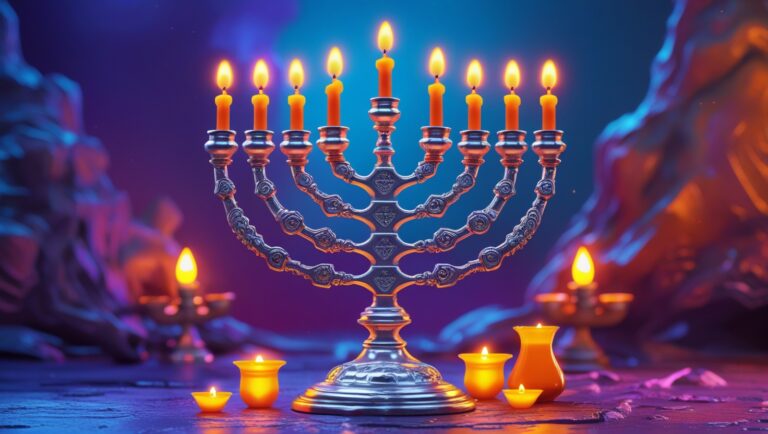Serach bat Asher has been one of the few characters in all of Tanach that have merited to enter Gan Eden (Garden of Eden) alive
This alone should speak volumes about the level she reached and her importance. Other examples of this marvelous feat include Chanoch, Eliyahu HaNavi, Yonah Ben Amitai (who was swallowed by the big fish) and, surprisingly, Batyah the daughter of Paraoh. These are individuals that have ascended the spiritual rungs until their physicality no longer weighted them down.
And, of course, one of these figures is Serach Bat (daughter of) Asher.
Among the many enigmatic characters ever chronicled in Scripture, Serach is renowned as the woman who melodiously alluded that Yosef was still alive to Yaakov Avinu. In doing so, she rekindled Yaakov’s spirit and was graced by the Patriarch with the gift of eternal life. Presumably, she received other blessings beyond mere longevity, as enduring through the ages alone doesn’t secure passage to Gan Eden. One needs a very exalted level of Tzadikut.
According to Abarbanel (drawing from the book of Kings) and the Midrash, she was the woman from Abel, consulted by Yoav (King David’s general), and that made her at least 684 years old. Yet, even in Pesikta D’Rav Kahana, we encounter her presence persisting far later, past the Second Temple’s downfall, her teachings remaining potent as we will see later.
So, what lessons can Serach impart, and how might her extensive life kindle inspiration within us?
Serach bat Asher’s role in Jewish History
Contrary to widespread understanding, Serach bat Asher’s role in Jewish history surpasses initial perception. In truth, a debate among commentators revolves around whether Serach or Yocheved (the mother of Moshe) should rightfully claim the distinction as the 70th soul accompanying Yaakov to Egypt.
Serach bat Asher’s name first appears in the count of Yaakov’s children as they go down to Egypt (Bereishit 46:17), “Asher’s children were Yimnah, Yishvi, Veria, and Serach bat Asher, their sister. Beriah’s children were Chever and Malkiel.” She is next mentioned when the Jews were counted to see how many had survived the plague in Shittim (Bamidbar 26:46), “The name of Asher’s daughter was Serach.” From this, it seems clear that Serach lived throughout the hundreds of years in Egypt.
As the Braita deSeder Olam Rabah (chapter 9) says, “Serach bat Asher was among those who entered Egypt and among those who left it. From those who entered Egypt as it says, ‘And Serach their sister.’ And she was among those who entered the Land as it says, ‘The name of Asher’s daughter was Serach.’”
In a similar vein the Midrash (Batei Midrashot 2, Midrash Eshet Chayil) says, “’She opens her mouth with wisdom’ (Mishlei 31:26), this is Serach bat Asher who never tasted the taste of death.”
More feats by Serach bat Asher
Discussing those people who never died, the Midrash Hagadol (Bereishis 46:25) states, “Serach bat Asher [is among them] because she said to Yaakov, ‘Yosef is alive.’ Yaakov said to her, ‘This mouth that related to me the news that he is alive, will never taste the taste of death!’”
Why does the above Midrash describe her as wise? As discussed in last week’s article, the brothers approached her to reveal to Yaakov that Yosef was still alive without him dying from shock. She broke the news to him subtly, either by hinting it to him in an intonation of surprise as he was praying (Can Yosef indeed be alive!), or by singing the words, “Yosef is alive,” as a song.
It is worth noting that other Midrashim (such as Massechet Kalla Rabati 3:23) describe her and others not as never tasting the taste of death, but as entering the Garden of Eden during their lifetimes. Some people may consider that these two concepts may boil down to the same thing, since when Chazal speak of someone living forever, it does not necessarily mean in their normal earthly form. As an example, the Zohar devotes much discussion to Eliyahu Hanavi’s exact whereabouts and his interaction with people over the centuries.
I personally reject this approach because it’s very clear from the Kitvei Ari and many other sources that Eliyahu HaNavi did go up in his “physical form” and can “come down” in physical form as well. Tzadikim can come and go as they please, and even return in a physical body for certain missions. This is also known from the Rosh (Rabbenu Asher Ben Yechiel), the famous codifier, who once came back in a physical body to study with his Chavruta.
As documented in the Gemara (Sotah 13A), Moshe was unaware of the whereabouts of Yosef’s remains. It wasn’t until Serach bat Asher disclosed that the Egyptians had encased them within a metal chest, subsequently casting it into the Nile, that Moshe could retrieve and elevate them.
Curiously, the Persian Jews residing in Isfahan believed that Serah bat Asher dwelled amongst them until the twelfth century CE when she tragically perished in a conflagration within their synagogue. This poignant connection prompted them to name the synagogue in her honor, echoing the enduring impact of her legacy.
Kabbalistic secrets from Serach bat Asher
The teachings of Zohar 3:167 reveal that Serach bat Asher is destined to become a prominent leader within the Women’s chambers of Olam HaBah—the World to Come. Her role will encompass the noble task of imparting Torah wisdom to righteous women who merit eternal rewards. This profound honor bestowed upon her is also underscored in Midrashic literature in the Midrash Gan Eden and Gehinom.
Among the mystical contemplations offered by the Arizal before sleeping lies the recitation of a particular Pasuk, repeated threefold in both its regular and inverted orders: “V’Shem Bat Asher Serach / Serach Asher Bat V’Shem” (“The name of the daughter of Asher is Serach”). This verse encapsulates one of Hashem’s sacred names and is regarded as a potent segulah against the evil eye.
Presumably, its recitation aids in elevating our souls during sleep, and invoking Serach’s merit.
The 5 Redemptions
Remarkably, the Zohar unveils that the five double letters ם ן ץ ף ך harbor the cryptic essence of the five redemptions. These are the 5 levels that represent the 5 Gevurot (or dinim) that are present in the physical and spiritual worlds because they are the only ones that have double form.
The letter ף (or its standard form פ) corresponds to the liberation from Egyptian bondage. Serach’s righteous father Asher specifically entrusted her with the secret formula of redemption—expressed through the words Pakod Pakadti (a dual declaration of the Jewish people’s remembrance and salvation as explained by the Ramchal in Ma’amar HaGeulah).
This concealed knowledge transcended generations from Avraham to Yitzhak, Yaakov, Yosef and his siblings, culminating with Serach—an implicit testament to her extraordinary spiritual stature.
The Yalkut Shimoni (Bereishis 12:64) records how, thanks to her longevity, Serach bat Asher played a key role in the redemption from Egypt:
“Rabbi Eliezer says, ‘Five letters were doubled, and all of them are an expression of redemption:
- [First is] kaf, kaf, through which Avraham was redeemed from Ur Kasdim as it says, ‘Go you (lech lecha) from your land.’
- Mem, mem, though which Yitzchak was redeemed from the Plishtim as it says, ‘Go from among us, for you have become far wealthier than us (mimenu meod).’
- Nun, nun, through which Yaakov was redeemed from Eisav as it says, ‘Please save me (hatzileini nah).’
- Pei, pei, through which Yisrael were redeemed from Egypt as it says, ‘I will surely redeem you (pakod pakadti).
- Ztadi, ztadi, through which the Holy One will redeem Yisrael at the end of the fourth kingdom as it says (Zechariah 6:12), ‘[Behold] a man, Tzemach is his name, and from his place will sprout (yitzmach) [the Mashiach].’
“Avraham passed these [signs] to Yitzchak, Yitzchak to Yaakov, Yaakov to Yosef, and Yosef to his brothers when he said to them, ‘When G-d surely redeems you, etc.’ (Bereishis 50:24). Asher ben Yaakov passed the secret of the redemption to Serach bat Asher his daughter.”
When Moshe and Aharon came to the elders of Yisrael and did the signs before them, the elders of Yisrael went to Serach bat Asher and said to her, ‘A certain man has come and made such and such signs before us.’ She said, ‘These signs are immaterial.’ They said, ‘But did he not say, ‘I will surely redeem’ (pakod pakadti)?’ She said, ‘He is the man! He has come to redeem Yisrael, because so I heard from my father, pei, pei. Immediately, ‘And the people believed, etc.’ (Shemos 4:31).”
In addition to this, the Yalkut (Devorim 34:965) reports how she played a crucial part in the fulfillment of the oath to take Yosef’s bones up to Eretz Yisrael, without which it would have been impossible to leave Egypt:
“’He buried him [Moshe] in the valley’ (Devorim 34:6). Why did Moshe merit that the Holy One dealt with him? Because at the time Yisrael were busy with the spoil, he wandered around the city for three days and three nights to find Yosef’s coffin, and he could not find it. After, he was very exhausted, and he met Serach bat Asher. She said to him, ‘Our master, Moshe, why are you so exhausted? He told her [everything]. She said to him, ‘Come with me,’ and she took him to the Nile River.
“She said to him, ‘At this place they made a lead coffin of five hundred kikars, and placed him inside, sealed it, and threw it into the river. Because the magicians said to Pharaoh, ‘Do you want this nation never leave your jurisdiction? Arrange that they cannot find Yosef’s bones and they will never leave here, because so he made them swear.’ Immediately, Moshe stood by the river, and threw a gold plating written “Alei Shor” on it.”
Savior of a City
After being included in the count of parshas Pinchos, Serach bat Asher disappears from history for hundreds of years, only to reappear in one of the rebellions that erupted during David HaMelech’s (King David’s) reign:
“A wicked man happened to arrive there, Sheva ben Bichri of Binyamin was his name. He blew a shofar and said, ‘We have no portion in David and we have no inheritance in Ben Yishai. Let each man of Yisrael [separate from him] and go to his tents… The men of Yoav, the Urim and Tumim, and all the warriors went out… to pursue Sheva ben Bichri… They came and besieged him in Aveilah… A wise woman called out from the town… and said, ‘I am among those of Yisrael who are peaceful and faithful [to David]. Do you seek to kill the great town of Yisrael…?’
“Yoav replied, ‘Not so is the matter. Rather… Sheva ben Bichri has rebelled against King David. Give only him and I will leave the town…’ The woman came to all the people with her wisdom, and they cut off Sheva ben Bichri’s head and threw it to Yoav…”
The Midrash (Midrash Mishlei 31) identifies this old woman as none other than Serach bat Asher:
“’She opens her mouth with wisdom and the Torah of chesed is on her tongue.’ This was the woman who spoke to Yoav and saved the town with her wisdom, and this was Serach bat Asher.”
The obvious question is – what was so wise about suggesting to her townspeople that they hand over the main culprit instead of all being killed? Isn’t this something anyone could have thought of?
The Tosefta (Terumos 7) explains that the people were concerned about the halachah that a group of people are sometimes forbidden to hand over one of them to be killed even if this leads to them all being killed:
“She said to them, ‘because he will be killed [in any case] and you too will be killed, give him to them. If he could escape, for example, if he was inside [in a more secure place] and you were outside, and you were in danger and he could escape, we would not push aside a life for a life to kill him so you should be saved. But now that he too will be killed with you, since the walls have been destroyed and there is no possibility of escape, it is better that he alone dies and you do not die with him.’
“Rabbi Shimon says, ‘This is what she said to them – someone who rebels against the Davidic Kingdom is liable for the death penalty.’”
As mentioned in an earlier article, this halachic discussion is relevant to many similar situations over the centuries, such as when the Nazis demanded that Jews hand over quotas of Jews who were taken to their deaths. And it all came from Serach bar Asher.
The Malbim explains their argument as follows: When Serach bat Asher claimed that the town was faithful to David, Yoav countered that their sheltering of Sheva ben Bichri was itself an act of rebellion. According to this approach, her wisdom was in persuading her townspeople that Yoav’s rationale was correct.
The last time Serach bat Asher appears in Chazal is over a thousand years later when she appeared in order to testify to a historical event:
“Rabbi Yochanan was sitting and teaching how the waters [of Yam Suf] were made into a wall for Yisrael. Rabbi Yochanan taught, ‘How were the waters? Like a woven network.’ Serach bat Asher looked in and said, ‘I was there, and they were like [the glass of] a shining lamp.’”
The Zayt Raanan on Yalkut Shimoni writes that she looked out from Gan Eden to give Rabbi Yochanan this information, which is puzzling.
Why was it so vital for her to correct Rabbi Yochanan’s understanding of what happened?
It was so crucial because if the partitions were like a woven network, the tribes would not have seen each other passing through different tunnels. With the wisdom of centuries, Serach bat Asher felt it vital to emphasize that the walls were like shining glass.
Even when the tribes were separate, they remained united, keeping sight of each other.
But then again, how could Rabbi Yochanan have had the supposedly “wrong” information? It seems to me there’s another lesson to be conveyed here, but that remains to be revealed.
Final remarks
One might ponder why so little is openly disclosed about Serach bat Asher
However, in the realm of Kabbalah, it is understood that significant heroes often reside in the shadows, beyond the limelight’s glare. They perform their sacred tasks concealed from the world’s gaze, shielded from the malevolent forces that may target them. As Rabbi Shimon taught: there’s only bracha upon that which is hidden from the eyes (Taanit 8:2)
At times, these heroes might even be overlooked or misunderstood. Serach’s story serves as a poignant reminder that regardless of how others perceive us, our actions could be monumental. Even the simplest acts of goodness can yield rewards that transcend our imagination.
Although Serach bat Asher’s name graces the pages of the Chumash merely twice, the sages of Chazal attribute to her pivotal contributions to various transformative events in the history of the Jewish People.
Indeed, these two verses acknowledge her presence and offer subtle hints of her extraordinary level.







